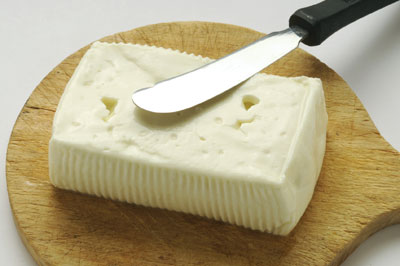
Cheese, please
Brandi Cowen
Features TrendsDiners are hungry for new flavours. Do your pizzas deliver?
There’s a whole world of cheeses to explore. Despite high tariffs, importers from around the globe are bringing flavours from as far away as Italy, Israel and India to Canadians.
There’s a whole world of cheeses to explore. Despite high tariffs,
importers from around the globe are bringing flavours from as far away
as Italy, Israel and India to Canadians.

|
| Formaggio stracchino can be a great addition to your menu’s cheese choices.
|
At the same time, cheese
production is thriving here at home. According to the Canadian Dairy
Information Centre (CDIC), Canada produced 399,544 kilograms and more
than 650 varieties of cheese last year. With so many options to choose
from and so many combinations to experiment with, it’s a great time to
consider changing up your cheese repertoire.
“It’s not just about pizza, it’s about cheese in many cases,” says
Kathy Guidi, president of Artisan Cheese Marketing and founder of the
Cheese Education Guild. Guidi also recently penned Canadian Cheese: A
Pocket Guide, which features tasting information for approximately 180
Canadian cheeses, many of them artisanal.
For an aficionado like Guidi, the cheese can make the difference
between a so-so pie and a truly memorable pizza experience. She can
still recall a particularly delectable pizza she enjoyed in Toronto:
“It was pretty special with fig and blue cheese. I think there may have
been something else besides just the blue, another softer, mellower
cheese, just to fill in the blanks. It was delicious.”
THE CASE FOR FRESH
Fresh cheeses, including mozzarella fior di latte (made from cow’s
milk) and mozzarella di Bufala (made from domesticated water buffalo
milk), taste great on pizza. Because the cheeses are fresh, they tend
to be healthier options, often containing lower levels of sodium and
fat than other types of cheese. That’s why Guidi recommends using fresh
cheeses to make healthier, tastier pies: “In the fresh category are the
ones that have the least salt but still deliver great flavour.”
Stracchino, a fresh cheese with a soft, creamy texture and mild
flavour, is also a delicious, low sodium cheese choice. Stracchino
works so well for pizza that, when asked about her dream pie, it’s the
first topping Guidi mentions.
“A nice thin crust, stracchino cheese, basil, thin slices of fresh
tomato and maybe I’d grate some hard cheese over the top that would
brown a little bit,” she describes enthusiastically. “A nice fine, hard
cheese – Asiago – if you wanted to add a little punch to that pizza.”
She pauses for a moment, then adds: “And maybe mushrooms.”
PLAY WITH YOUR FOOD
Incorporating novel cheese varieties into your pies can make your
pizzas stand out from the competition, but it can also be a risky move.
If customers are unfamiliar with a particular variety of cheese, they
may hesitate to order an entire pizza topped with something they may
not like.
Cheeseboards can help diners overcome this fear of the unknown,
offering a taste of an unfamiliar cheese without having to commit to an
entire meal featuring that flavour. Boards typically feature three to
five selections, including one soft and one firm cheese (such as
Camembert and Asiago), and a blue vein cheese (like a Roquefort). A
spreadable cheese, such as a fresh chêvre, and a cheese selection
flavoured with herbs or wine can be used to round out the board.
A cheese board can serve dual purposes, expanding your patrons’ taste
horizons, and opening your pizzeria to a world of new pie possibilities.
“I think the opportunity more and more for restaurants is to use some
of your ends of cheeses and grate them up, shred them, and use them on
a pizza,” Guidi says. “Any cheese will melt and some of the finer
artisan cheeses will actually brown. It would be a lovely way to use up
some of the cheese from your cheese boards.”
She points out that many cheeses are “very flavourful,” so you may not
need to use very much in order to add an exciting new flavour to your
pies. Guidi suggests that somewhere between 30 and 40 per cent of the
cheese on a pizza be of a specialty variety, while the remainder can be
a more basic cheese choice.
Guidi also recommends offering mini-pizzas made with artisan cheeses.
This idea capitalizes on the growing trend towards offering more snack
items. It also gives customers another opportunity to test out a new
flavour in an easy-to-share way, without committing to an entire meal.
For the very cautious customer, consider offering samples of the
cheeses your kitchen works with. Taking your customers out of their
comfort zones and exposing them to new varieties of cheese can create
opportunities to change up your menu while giving diners a flavour
experience that will keep them coming back for more.
Print this page